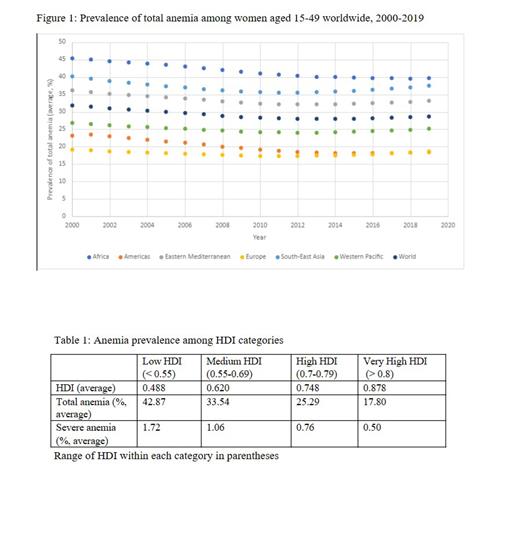Introduction: A common disease with significant impacts on health and quality of life, anemia is particularly prevalent in women of reproductive age due to blood losses during menstruation and pregnancy. Data from the World Health Organization (WHO) was analyzed to compare trends in prevalence of anemia in women aged 15-49 among countries and over time with the goal of identifying regions both successful and in need of assistance in combatting anemia.
Methods: Publicly available data was obtained from the WHO on the prevalence of anemia among women aged 15-49 from 194 countries from 2000-2019, data being reported as percentages. Anemia was defined as hemoglobin < 12 g/dL for non-pregnant women and < 11 g/dL for pregnant women, with severe anemia being defined as hemoglobin < 8 g/dL for non-pregnant women and < 7 g/dL for pregnant women. WHO data was from both individual-level and summary statistics sources and hemoglobin was adjusted for altitude. Human development index (HDI) data and categories (low, medium, high, and very high) were obtained from the United Nations. Data was analyzed based on year, country, geographic region, and HDI, with ANOVA and Tukey HSD tests being used to analyze the relationship between HDI and anemia.
Results: Worldwide from 2000 to 2013 the prevalence of anemia decreased, and then increased from 2013 to 2019 though remained lower than at 2000 levels; severe anemia decreased throughout the world from 2000 to 2019. Throughout all years, African countries had the highest prevalence of anemia and severe anemia while American and European countries had the lowest (Figure 1). When analyzed by HDI category, there was a significant difference among HDI categories with both total and severe anemia ( P < 0.001 for both). With each decrease in HDI category (very high to high, etc.) there was a significant increase in prevalence of total anemia (Table 1, P < 0.001 for all). For severe anemia, there was a significant difference in prevalence of anemia between all HDI levels except very high and high ( P = 0.09).
Discussion: This data suggests that although the prevalence of anemia among reproductive age women has decreased over time there is still much work remaining, particularly in low HDI countries, where the prevalence of anemia was over twice that of very high HDI countries in 2019, and the prevalence of severe anemia was over three times as high. More research is needed into the relationship of anemia and socioeconomic status as well as preventing, recognizing and treating anemia.
Disclosures
No relevant conflicts of interest to declare.


